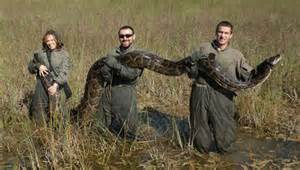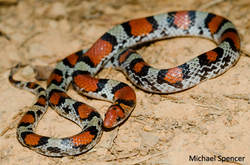Snakes
|
Florida Snakes
Florida is home to 46 species of native snakes, only 6 of which are venomous. Venomous snakebites are rare and can often be avoided; however, responding correctly to venomous snakebites is important. Learn more... Snakes play important roles in our natural ecosystems and should be respected rather than feared. Snakes are important predators that help control rodent populations that can spread disease to humans. They are also important prey for birds, mammals, alligators, and even other snakes. Some non-venomous snakes, such as the Eastern Indigo Snake and Common Kingsnake, even eat venomous snakes! Florida has also been invaded by four species of non-native snakes, three of which have established breeding populations. These snakes are native to tropical and sub-tropical habitats and are able to survive in Florida's hospitable climate. One introduced species, the Burmese Python, is probably having negative impacts on our native wildlife in the Everglades. Florida is also home to two groups of legless lizards that are often mistaken for snakes. For more information go to: http://ufwildlife.ifas.ufl.edu/snakes/florida.shtml Pythons - Native and Non-Native While Florida has seen a dramatic rise in the python population, only one report has come in of a sighting in our neighborhood. Most of them are down in the Everglades. However, it is important to know what you are looking at should you see a very big snake. The Burmese Python is shown here. If you spot one, report it to http://www.evergladescisma.org/how-you-can-help/ Size ranges from 2 ft. (hatchling) up to 18 ft. (max. ~20 ft.) Its large, heavy body is yellowish tan to light brown. Back and sides are marked with darker reddish brown blotches bordered with black; blotches on the back usually do not touch. Head is marked with a dark brown "V" shaped blotch with a tan line down the center. Whitish tan wedges bordered by dark wedges run from each eye to the corner of the jaw. Belly is unmarked down the center. Scales are smooth and shiny. This snake lays eggs. Its habitats are currently mainly in southern Florida. It is invasive and usually found in or near freshwater aquatic habitats such as marshes, swamps, and canals. It has been found in greatest numbers in the Everglades, but it may be able to adapt to a wide variety of forested and open habitats and could spread throughout Florida and other parts of the southeastern U.S. This species is not native to Florida. It was introduced as a result of accidental escapes and intentional releases of pet snakes. Its diet is alligators, birds, mice, rats, squirrels, rabbits, cats, bobcats, opossums, raccoons, deer and other animals. A good guide to pick up to help identify snakes is the “Field Identification of Select Native and Nonnative Reptiles in Florida". This guide also includes native snakes which hopefully you won’t kill. As a rule of thumb, if it’s not 8 feet or more long or as big around as a full size coffee can, don’t kill it! |
|






